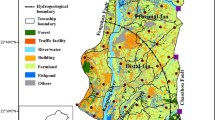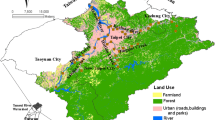Abstract
Assessing aquifer vulnerability is crucial for preventing groundwater pollution. In this study, aquifer vulnerability to fecal coliform (FC) pollution was assessed using auxiliary environmental data in the Pingtung Plain, Taiwan. Moreover, key environmental factors inducing different fecal pollution levels were determined. First, 23 explanatory variables on land uses, population density, livestock and poultry densities, sanitary condition, antecedent precipitation, groundwater quality, aquifer characteristics, and subsurface hydrology were obtained using geographic information systems in 2014. As dependent variables, groundwater FCs were also simultaneously obtained. Then, multi-threshold logistic regression (LR) was adopted to model aquifer vulnerability assessment after cross validation. The thresholds of aquifer vulnerability causing risks of incidental ingestion were analyzed by risk assessment. Risks to human health were acceptable for a low-level threshold and exceeded the acceptable level for medium- and high-level thresholds when residents incidentally ingested FC-polluted groundwater. Finally, key environmental factors inducing low, medium, and high levels of groundwater FC pollution were characterized. The key environmental factors for the LR with low- and medium-level thresholds were sand and gravel soil textures of unsaturated aquifers and antecedent 3-day cumulative precipitation, and those for the LR with high-level thresholds were chicken farming, urban land use, and ratio of tap water use. Thus, the multi-threshold LR indicated that environmental factors must be ranked for assessing aquifer vulnerability.








Similar content being viewed by others
Data availability
Data will be made available on reasonable request.
References
Aelion, C. M., & Conte, B. C. (2004). Susceptibility of residential wells to VOC and nitrate contamination. Environmental Science & Technology, 38, 1648–1653.
Agriculture Engineering Research Center (AERC). (2014). Survey, analysis and assessment of groundwater quality of Taiwan in 2012 – 2014 (3/3). Water Resources Agency, Ministry of Economic Affairs, Executive Yuan, Taiwan, pp 85–101.
Antonakos, A. K., & Lambrakis, N. J. (2007). Development and testing of three hybrid methods for the assessment of aquifer vulnerability to nitrates, based on the drastic model, an example from NE Korinthia, Greece. Journal of Hydrology, 333, 288–304.
Assaf, H., & Saadeh, M. (2009). Geostatistical assessment of groundwater nitrate contamination with reflection on DRASTIC vulnerability assessment: The case of the upper Litani basin, Lebanon. Water Resources Management, 23, 775–796.
Chen, S. K., Jang, C. S., & Chang, C. P. (2020). Employing indicator-based geostatistics and quantitative microbial risk analysis to assess the health risks of groundwater use for household demands on the Pingtung Plain. Taiwan. Environmental Geochemistry and Health, 42(7), 2007–2021.
Eleria, A., & Vogel, R. M. (2005). Predicting fecal coliform bacteria levels in the Charles River, Massachusetts, USA. Journal of the American Water Resources Association, 41(5), 1195–1209.
Fatahi Nafchi, R., Yaghoobi, P., Reaisi Vanani, H., Ostad-Ali-Askari, K., Nouri, J., & Maghsoudlou, B. (2021). Eco-hydrologic stability zonation of dams and power plants using the combined models of SMCE and CEQUALW2. Applied Water Science, 11, 109.
Fatahi Nafchi, R., Raeisi Vanani, H., Noori Pashaee, K., Samadi Brojeni, H., & Ostad-Ali-Askari, K. (2022). Investigation on the effect of inclined crest step pool on scouring protection in erodible river beds. Natural Hazards, 110, 1495–1505.
Genthe, B., & Rodda, N. (1999). Application of health risk assessment techniques to microbial monitoring data. WRC Report No. 470/1/99. Water Research Commission, Pretoria, South Africa.
Geosyntec. (2008). Dry and wet weather risk assessment of human health impacts of disinfection vs. no disinfection of the Chicago Area Waterways System (CWS). Metropolitan Water Reclamation District of Greater Chicago, Chicago, pp 99–110.
Gurdak, J. J., & Qi, S. L. (2012). Vulnerability of recently recharged groundwater in principle aquifers of the United States to nitrate contamination. Environmental Science and Technology, 46(11), 6004–6012.
Haas, C. N., Rose, J. B., & Gerba, C. P. (2014). Quantitative microbial risk assessment. (The 2nd edition). Wiley, New York, pp 37–40, pp 79, pp 271–274, and pp 293.
Haas, C. N. (2015). Microbial dose response modeling: Past, present, and future. Environmental Science & Technology, 49(3), 1245–1259.
Herrig, I. M., Böer, S. I., Brennholt, N., & Manz, W. (2015). Development of multiple linear regression models as predictive tools for fecal indicator concentrations in a stretch of the lower Lahn River, Germany. Water Research, 85, 148–157.
Hynds, P. D., Misstear, B. D., & Gill, L. W. (2012). Development of a microbial contamination susceptibility model for private domestic groundwater sources. Water Resources Research, 48, W12504. https://doi.org/10.1029/2012WR012492
Jang, C. S., & Chen, S. K. (2015). Integrating indicator-based geostatistical estimation and aquifer vulnerability of nitrate-N for establishing groundwater protection zones. Journal of Hydrology, 523, 441–451.
Jang, C. S. (2021). Using multi-threshold regression techniques to assess river fecal pollution in the highly urbanized Tamsui River watershed. Environmental Monitoring and Assessment, 193, Article 113.
LaMotte, A. E., & Greene, E. A. (2007). Spatial analysis of land use and shallow groundwater vulnerability in the watershed adjacent to Assateague Island National Seashore, Maryland and Virginia, USA. Environmental Geology, 52(7), 1413–1421.
Liang, Z., He, Z., Zhou, X., Powell, C. A., & Yang, Y. (2013). Impact of mixed land-use practices on the microbial water quality in a subtropical coastal watershed. Science of the Total Environment, 449, 426–433.
Medema, G., & Ashbolt, N. (2006). QMRA: Its value for risk management. MICRORISK, KWR Water Research Institute, Swedish.
Menció, A., Boy, M., & Mas-Pla, J. (2011). Analysis of vulnerability factors that control nitrate occurrence in natural springs (Osona Region, NE Spain). Science of the Total Environment, 409(16), 3049–3058.
National Research Council. (1993). Ground water vulnerability assessment: Predictive relative contamination potential under conditions of uncertainty (pp. 42–63). National Academy Press.
O’Dwyer, J., Dowling, A., & Adley, C. C. (2014). Microbiological assessment of private groundwater-derived potable water supplies in the Mid-West Region of Ireland. Journal of Water and Health, 12(2), 310–317.
Óhaiseadha, C., Hynds, P. D., Fallon, U. B., & O’Dwyer, J. (2017). A geostatistical investigation of agricultural and infrastructural risk factors associated with primary verotoxigenic E. coli (VTEC) infection in the Republic of Ireland, 2008–2013. Epidemiology and Infection, 145, 95–105.
Ostad-Ali-Askari, K., Shayannejad, M., & Ghorbanizadeh-Kharazi, H. (2017a). Artificial neural network for modeling nitrate pollution of groundwater in marginal area of Zayandeh-rood River, Isfahan. Iran. KSCE Journal of Civil Engineering, 21, 134–140.
Ostad-Ali-Askari, K., Shayannejad, M., Eslamian, S., Zamani, F., Shojaei, N., Navabpour, B., Majidifar, Z., Sadri, A., Ghasemi-Siani, Z., Nourozi, H., Vafaei, O., & Homayouni, S. (2017b). Chapter No. 18: Deficit irrigation: Optimization models. Management of Drought and Water Scarcity. Handbook of Drought and Water Scarcity, 3, 373–389. Taylor & Francis Publisher. Imprint: CRC Press.
Ostad-Ali-As, K. (2022). Investigation of meteorological variables on runoff archetypal using SWAT: Basic concepts and fundamentals. Applied Water Science, 12, 177.
Pacheco, F. A. L., & Sanches Fernandes, L. F. (2013). The multivariate statistical structure of DRASTIC model. Journal of Hydrology, 476, 442–459.
Putri, L. S. E., Kustanti, N., & Yunita, E. (2013). Effect of land use on ground water quality (A case study from Ciracas Sub District, East Jakarta, Indonesia). International Journal of Bioscience, Biochemistry and Bioinformatics, 3(1), 33–36.
Rijal, G., Tolson, J. K., Petropoulou, C., Granato, T. C., Glymph, A., Gerba, C., Deflaun, M. F., O’Connor, C., Kollias, L., & Lanyon, R. (2011). Microbial risk assessment for recreational use of the Chicago Area Waterway System. Journal of Water and Health, 9(1), 169–186.
Seis, W., Zamzow, M., Caradot, N., & Rouault, P. (2018). On the implementation of reliable early warning systems at European bathing waters using multivariate Bayesian regression modelling. Water Research, 143, 301–312.
Sharma, S. (1996). Applied multivariate techniques (pp. 317–341). John Wiley Sons Inc.
Somaratne, N., Zulfic, H., Ashman, G., Vial, H., Swaffer, B., & Frizenschaf, J. (2013). Groundwater risk assessment model (GRAM): Groundwater risk assessment model for wellfield protection. Water, 5, 1419–1439.
Swets, J. A. (1995). Signal detection theory and ROC analysis in psychology and diagnostics: Collected papers. Lawrence Erlbaum Associates.
Taiwan Central Geological Survey. (2002). Hydrogeological survey report of Pingtung Plain, Taiwan. Central Geological Survey, Ministry of Economic Affairs, Executive Yuan, Taiwan, pp 97–142.
Taiwan Water Corporation (2014). Annual Statistics Report in 2014. Taiwan Water Corporation, Executive Yuan, Taiwan. Available at https://www.water.gov.tw/np.aspx?ctNode=1090&mp=1. Retrieved December 1, 2021.
Tesoriero, A. J., & Voss, F. D. (1997). Predicting the probability of elevated nitrate concentrations in the Puget Sound basin: Implications for aquifer susceptibility and vulnerability. Ground Water, 35(6), 1029–1039.
Ting, C. S., Zhou, Y., de Vries, J. J., & Simmers, I. (1998). Development of a preliminary ground water flow model for water resources management in the Pingtung plain. Taiwan. Ground Water, 36(1), 20–36.
US Environmental Protection Agency. (EPA) (1986). Ambient water quality criteria for bacteria -, 1986 EPA 440-5-84-002 US Environmental Protection Agency 15.
US Environmental Protection Agency (EPA). (2001). Risk assessment guidance for superfund (RAGS) Volume III - Part A: Process for conducting probabilistic risk assessment. Office of Emergency and Remedial Response, US Environmental Protection Agency Washington, DC, pp 3–1~3–27 and pp A-1~A-31.
US Environmental Protection Agency (EPA). (2002). Implementation guidance for ambient water quality criteria for bacteria. Office of Water, US Environmental Protection Agency, Washington, DC, (EPA-823-B-02–003) pp 7–9.
US Environmental Protection Agency (EPA). (2014). Microbiological risk assessment (MRA) tools, methods, and approaches for water media. Office of Science and Technology Office of Water US Environmental Protection Agency Washington, DC, (EPA-820-R-14–009) pp 90–94 and pp 104–110.
US Environmental Protection Agency. (2012). Recreational Water Quality Criteria. Office of Water, United States Environmental Protection Agency, Washington, DC, (EPA-820-F-12-058) pp. 14.
Verhougstraete, M. P., Martin, S. L., Kendall, A. D., Hyndman, D. W., & Rose, J. B. (2015). Linking fecal bacteria in rivers to landscape, geochemical, and hydrologic factors and sources at the basin scale. Proceedings of the National Academy of Sciences, 112(33), 10419–10424.
World Health Organization (WHO). (2003). Guidelines for safe recreational water environments. Vol. 1. Coastal and Fresh Waters. World Health Organization, Geneva, Switzerland, pp 82–87.
World Health Organization (WHO). (2016). Quantitative microbial risk assessment: Application for water safety management (pp. 171–179). World Health Organization.
Wu, J., Yunus, M., Islam, M. S., & Emch, M. (2016). Influence of climate extremes and land use on fecal contamination of shallow tubewells in Bangladesh. Environmental Science and Technology, 50(5), 2669–2676.
Xu, G., Wang, T., Wei, Y., Zhang, Y., & Chen, J. (2022). Fecal coliform distribution and health risk assessment in surface water in an urban-intensive catchment. Journal of Hydrology, 604, 127204.
Acknowledgements
The author would like to thank the Agriculture Engineering Research Center generously supporting data on groundwater FC and DOC in the Pingtung Plain, and the Ministry of Science and Technology, Taiwan for financially supporting this research under Contract No. MOST 108-2621-M-424-001.
Author information
Authors and Affiliations
Corresponding author
Ethics declarations
Conflict of interest
The author declares no competing interests.
Additional information
Publisher's Note
Springer Nature remains neutral with regard to jurisdictional claims in published maps and institutional affiliations.
Rights and permissions
Springer Nature or its licensor holds exclusive rights to this article under a publishing agreement with the author(s) or other rightsholder(s); author self-archiving of the accepted manuscript version of this article is solely governed by the terms of such publishing agreement and applicable law.
About this article
Cite this article
Jang, CS. Aquifer vulnerability assessment for fecal coliform bacteria using multi-threshold logistic regression. Environ Monit Assess 194, 800 (2022). https://doi.org/10.1007/s10661-022-10481-2
Received:
Accepted:
Published:
DOI: https://doi.org/10.1007/s10661-022-10481-2




